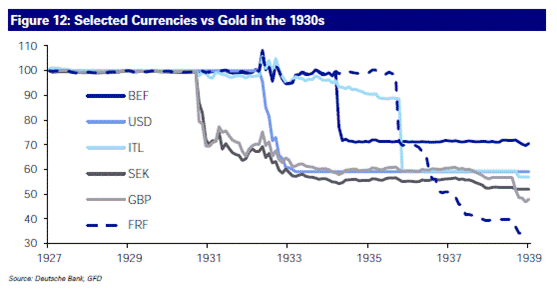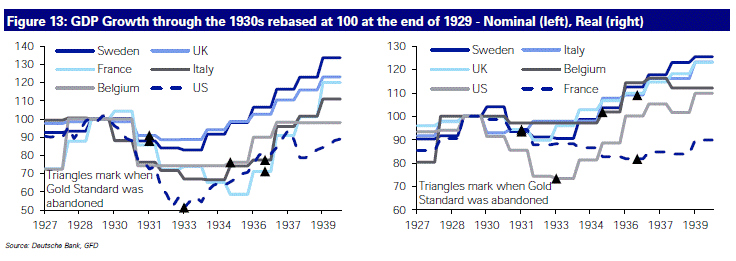|
Over the past six months there have been a few parallels made between the Gold Standard of the 1930s and the Euro economies; to names
In February 2012, Variant Perception noted:
"The euro is like a modern day gold standard where the burden of adjustment falls on the weaker countries".
A few months later, Hugh Hendry remarked:
"We still see the global economy as grotesquely distorted by the presence of fixed exchange rates, the unraveling of which is creating financial anarchy, just at it did in the s and 1930s. Back then the relevant fixes were around the gold standard. Today it is the dual fixed priceing regimes of the euro and the dollar/reminbi peg."
In 2000, a certain Ben Bernanke left the most notable mark on the topic in his "Essays on the Great Depression":
"Countries that left gold were able to reflate their money supplies and price levels, and did so after some delay; countries remaining on gold were forced into further deflation. To an overwhelming degree, the evidence shows that countries that left the gold standard recovered from the Depression more quickly than countries that remained on gold."
More recently, in December 2011, a thorough analysis on the subject came from Deutsche Bank; here are a few excerpts from their report:
"We think the tensions that led most countries to abandon the Gold Standard one-by-one in the 1930s are present today."
"In addition to the fiscal squeeze, monetary conditions could also be tightened by bank deleveraging even if central banks maintain easy conditions. In this regard, the US in 1937 is a stark warning of the potential dangers of removing stimulus too soon after a huge financial crisis."
Figure 1: Devaluations to Gold (left) and Real GDP Growth (right) through the 1930s

1971 to Today
On the devaluation seen since August 1971 (the point the Gold Standard was abandoned) against the Deutschemark:
"Although Greece suffered the most severe devaluation, there were many countries that were almost as bad, in terms of being ‚serial devaluers�. Portugal, Italy, Spain and Ireland saw their currencies sink -93%, -82%, -76% and -70% respectively between the end of the Gold Standard and the start of the Euro with Italy and Spain devaluing by around 24% in the decade leading up to the Euro’s introduction."
"Unfortunately, the evidence since the Euro was introduced is that the competitiveness of all of these countries vis-a-vis Germany has continued to deteriorate enough to suggest that further significant devaluations would have occurred had the Euro not been put in place thus leaving pressure points to varying degrees of intensity for all member states."
Currencies in the 1930s
"The 1930s in Europe was a slow moving game of falling dominoes with countries one by one leaving the narrow confirnes of the Gold Standard after chronic growth problems that a fixed currency system intensified. There was a definite trend in the 1930s that saw those countries that left the Gold Standard seeing a much quicker recovery from the Depression than those that stayed on for a number of years into the latter half of the decade."
"Figure 12 shows a case study of six countries currencies relative to Gold in the 1930s. We’ve rebased them to 100 at the start of the series. In order of leaving the Gold Standard, we had the UK (left September 1931), Sweden (also left September 1931), US (April 1933), Belgium (March 1935), France (September 1936) and Italy (October 1936)."

"Interestingly, by the middle of 1937 all had devalued by at least 40% to Gold except Belgium who had devalued by around 30% in 1935. France, which held on until September 1936, then saw its currency collapse by nearly 70% in the three years up to WWII. Figure 13 then shows the same six countries nominal (left) and real (right) GDP performance over the same period."
"The Euro reminds us of the Gold Standard, where the longer the country remained on the Gold Standard the longer it took for the economy to restore their pre-1929 levels of activity."

|